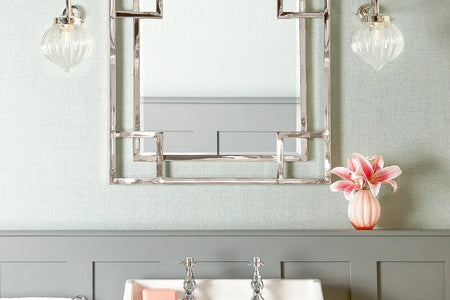 To mark the launch of Pooky’s new Abstactifications range, here’s a look at how sculptural table lamps can be taken to the max, and add an artistic wow to your home..
To mark the launch of Pooky’s new Abstactifications range, here’s a look at how sculptural table lamps can be taken to the max, and add an artistic wow to your home..
Lights have always been a good excuse to bring some beauty into the home. More than any other household appliance, they fulfil both parts of William Morris’ famous dictum: ‘Have nothing in your house that you do not know to be useful, or believe to be beautiful’.
From the earliest days of electric lighting, designers have been turning these practical necessities into glorious decorative objects: just as lovely when switched off in daylight as they are when casting a glow about your room. There’s Louis Tiffany’s astonishing Art Nouveau glass shades, Rene Lalique’s Art Deco lighting masterpieces – and indeed virtually all the greats of 20th century architecture from Frank Lloyd Wright to moderrnist Arne Jacobsen have created iconic lights. Their ideas have inspired many of Pooky’s most loved and most unusual table lamps.
So why not take it a step further… stepping boldly across that fuzzy line between great design and fine art? Our new collection of table lamps is our most avant-garde ever, taking its inspiration from modernist abstract sculpture.
And if you like the look of them, then consider these three very good reasons to add an expressive, attention-grabbing sculptural lamp to your home..
1) They let you make room for art – Paintings and prints are one thing, but it’s not easy fitting three-dimensional artworks into your home; few people have much space for a plinth. But because sculptural lamps double up with the additional function of lighting your room, they easily justify their place on the side table or windowsill.
2) They create ‘wow’ moments around the house – designer lamps can either blend in with and complement your decor; or they can stand out from it, loud and proud. Sit one of these abstract expressionist showstoppers in an otherwise minimalist, neutral area and you’ll create a stunning ‘gallery’ effect to wow your visitors.
3) They allow you to express yourself – sometimes an artwork sings to you and you just know it’s you…. Put it on display and you’ll enjoy it every day, because it expresses a part of your personality that might otherwise be hidden from view.
The Abstractification collection - and some sculptural inspiration
Each of the lights in our Abstractification collection is inspired by a fine tradition of abstract modernist sculpture – here’s a closer look at them, along with some of their artistic ancestors…
Polyphemus
 Polyphemus alabaster table lamp
Polyphemus alabaster table lamp
In Greek legend, Polyphemus was the Cyclops that caused Odysseus such trouble on his journey home from Troy. This beautifully distinctive light washes soft light through its single alabaster ‘eye’.
Inspiration: One-eyed giants aside, Polyphemus might also put you in mind of the abstracted figures of Britain’s best-known modernist sculptor, Sir Henry Moore (1898-1986). Moore spurned representational Victorian sculpture and experimented with form and space. He created a new kind of figurative sculpture, showing reclining and mother-and-child figures in abstracted organic forms that referenced the rolling English landscape (which is exactly where his works are most often to be found).
 Sir Henry Moore - Double Oval (1966). Image: creative commons
Sir Henry Moore - Double Oval (1966). Image: creative commons
Discus
 Discus in gold and white marble
Discus in gold and white marble
With its gold disc and white marble base, Discus is an imaginative alternative to the traditional lamp-and-shade lighting solution. It’s best set up against a wall, so the light bounces back and reflects around the room from the centre and edges of the discus.
Inspiration: The abstract shape set on a block and pierced with a hole is a recurring motif in the work of that great contemporary (and friend) of Henry Moore, Barbara Hepworth (1903-75). Like Moore, Hepworth was excited by direct carving of wood as well as sculpting stone and casting in bronze, but rather than representing people or things, she focussed on pure shapes. 
Barbara Hepworth sculpture at the Barbara Hepworth Museum and Sculpture Garden in St. Ives. Image credit: Puffin11k via creative commons
Knotty

Knotty sculptural table lamp in gold and white marble
Knotty is quite unlike anything we’ve ever made before, and it’s remarkably effective as a lamp as well as an artwork: pushed up close against the wall the light reflects and creates a warm glow.
Inspiration: Perhaps the most avant-garde of all the Abstracifications collection, there’s more than a hint of the great German-French artist and Dada-ist Jean Arp (1886-1996) to its wildly creative form. Arp was one of the first artists to really push sculpture into the extremes of abstract art, and was a major influence on Moore and Hepworth.

Jean Arp - Ptolemy III, 1961. Bronze (1886-1966) UCLA Sculpture Garden. Image credit: Rob Corder via creative commons.
Splash
Resembling the concentric rings from throwing a misshapen stone into a pond, when lit Splash casts a light that’s soft, pleasing, and a little hypnotic.
Inspiration: An organic wave form, Splash conjures the spirit of the American artist Robert Smithson, creator of one of the most unusual abstract ‘sculptures’ on the planet… Spiral Jetty (1970) is a 460 metre-long earthwork made from basalt rocks and mud in the Great Salt Lake, Utah. It’s considered one of the most important works of modern US art – at any rate it must be one of the biggest.
 Robert Smithson - Spiral Jetty (1970). Image: public domain
Robert Smithson - Spiral Jetty (1970). Image: public domain
Feeling artistically inspired? Take a wander through the Abstractificians collection here…
See also:
Eight unusual table lamps – which is your favourite quirky light?
Picture lights - how to illuminate your paintings and artworks












